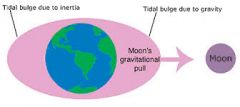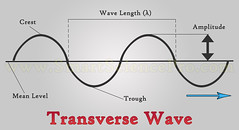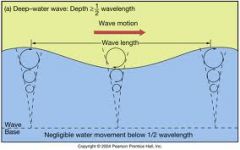![]()
![]()
![]()
Use LEFT and RIGHT arrow keys to navigate between flashcards;
Use UP and DOWN arrow keys to flip the card;
H to show hint;
A reads text to speech;
94 Cards in this Set
- Front
- Back
|
How many people live near the beach? How many by 2030? |
3.6 billion (60%) people live within 60 km of the world’s coastlines 6.4 billion (75%) will live there by 2030 |
|
|
What are tides? |
Tides are the periodic raising and lowering of sea level in the oceans due to gravitational and centripetal forces |
|
|
How are tides classified? |
Tides are shallow water waves and can be described using common wave characteristics: crest, trough, period, wavelength & wave height – more commonly called tidal range) |
|
|
What generates tides? |
Gravitational forces between the Earth, Moon and Sun Centripetal forces generated due to rotation of the Earth, Moon and Sun around one another |
|
|
What is gravitational force? |
Any two masses attract one another with a force that is -directly proportional to the product of their masses -inversely proportional to the square of the distance between them Gravitational force is sensitive to distance between objects |
|
|
Describe the gravitational force off the moon |
Gravitational force varies over surface of earth in both magnitude and direction Magnitude of force is 7% larger at zenith (point on earth closest to moon) than at nadir (point on earth furthest from moon) Direction of force is always oriented toward center of Moon |
|
|
What does centripetal force create? |

Tidal bulge |
|
|
What creates tidal force? |
Tidal force results from difference between centripetal and gravitational forces; strongest at zenith and nadir, weakest along plane perpendicular to zenith/nadir; tidal force varies inversely with the cube of the distance between objects |
|
|
How are ideal tides produced? |
Ideal tidal pattern results from the rotation of earth underneath tidal bulge creating semidiurnal pattern |
|
|
What is a semidiurnal tide? |
2 highs, 2 lows every day; both highs and both lows are of equal tidal height |
|
|
How long is a lunar day? |
24 hours + 50 minutes |
|
|
What is the role of the sun in tides? |
When moon and sun are aligned the bulges constructively interfere with each other creating larger tides (i.e., spring tides) When they are not aligned they destructively interfere with each other creating lower tides (i.e., neap tides) |
|
|
Declination |
the angular distance of a point north or south of the celestial equator. The moon has a declination of 28.5º with respect to the equator |
|
|
What does the dynamic theory of tides examine? |
Takes into account the presence of land; the Coriolis Effect; the fact that the tides are a shallow water wave (and must behave accordingly) |
|
|
Seiche |
Restricted bays and inlets result in specific period waves which can modify or amplify the open ocean tidal patterns |
|
|
Bay of Fundy |
Largest tidal ranges in world observed in bay |
|
|
Tidal currents |
Alternating horizontal movement of water associated with the rise and fall of the tide.
Generated as the tide pushes and pulls water into and out of bays, inlets and estuaries |
|
|
How do tidal currents affect the ocean |
-Dictates where boats can be easily moored -Dictates chemical conditions suitable for planktonic organisms -Dictates sediment grain size distribution |
|
|
Maelstrom |
Regions where tidal currents interact with bottom topography or coastline to create a whirlpool |
|
|
Tidal bore |
-Wall of water generated as the incoming tide interacts with outgoing flow from river -Period of tidal bore defined by the length and depth of the semi-enclosed basin |
|
|
What is a wave? |
Waves represent the transfer of energy through a medium |
|
|
Transverse waves |

Occur in solid medium Example: S-waves from earthquakes (where shear stress provides restoring force)
|
|
|
Logitudinal Waves |

Occur in solid, liquid or gas Example: sound waves (pressure provides restoring force)
|
|
|
Orbital waves |

Occur in liquid or gas (aspects of both longitudinal & transverse) Example: ocean waves (gravity provides restoring force)
|
|
|
Generated forces |
Wind, earthquakes, gravitational effects of sun/moon |
|
|
Restoring force |
Gravity |
|
|
Deep water waves |
Generated by winds -wave travels through water that is deeper than ½ L -Deep-water waves have a fixed relationship between celerity (C), wavelength (L) and period (T) |
|
|
Shallow water waves |
Generated by seismic disturbance, tidal forces, landslides -wave travels through water that is less than 1/20 L |
|
|
Potential energy |
Related to wave height |
|
|
Kinetic energy |
Related to wave speed |
|
|
How do deep water waves change in surf zone? |
Wave base feels friction of bottom and slows Energy converted from kinetic to potential Period of wave stays constant, but wavelength shortens Wave height increases in size and eventually wave breaks |
|
|
Groups speed |
The deep-water waves making up the train is less than the speed of the individual waves in the train |
|
|
Describe Miller Experiment |
Confirmed hypothesis that organic molecules can form from constituents of Earth’s early atmosphere & ocean Basic building blocks of life – sugars, fatty acids, amino acids – were formed from H2O, CH4, NH3, H2 This process required external energy in form of ultraviolet light & lightning |
|
|
Heterotrophs |
Heterotrophs: need energy from organic molecules contained in the “primordial stew” |
|
|
Prokaryotes |
Prokaryotes: small, single celled with no nucleus to segregate genetic material from rest of cell |
|
|
Linnaean Classification System |
Taxonomic classification is a system that differentiates organisms based on differences in form, structure or shape |
|
|
What are the classifications for Kingdoms? |
Basis of nutrition -Autotrophic -Heterotrophic Cellular organization -Single cell w/o nucleus -Single cell w/ nucleus -Multicellular Motility -Free-moving -Non-motile |
|
|
Describe the purpose of diffusion |
Organisms must also be able to take in nutrients and expel waste A high surface area to volume ratio makes passive diffusion much more efficient Little energy required in passive diffusion |
|
|
Hypotonic |
cells have less ionic concentration than surrounding seawater |
|
|
Hypertonic |
cells have higher ionic concentration than surrounding seawater |
|
|
Osmosis |
drives water from their cells into seawater |
|
|
Solution |
drink copious amounts of seawater and excrete the excess salts through gills |
|
|
Isotonic |
cells have similar ionic concentration as surrounding seawater |
|
|
Osmosis |
has no net effect on water in cell |
|
|
What chemicals do sharks and rays use in blood to maintain osmotic balance (not zooplankton)? |
urea and trimethylamine oxide |
|
|
Poikilotherms |
Invertebrates and fish that cannot control body temp Need special proteins in really cold environments to prevent blood from freezing |
|
|
Homeotherms |
Seabirds and marine mammals that can control body temp very precisely Maintain temp that is higher than surrounding seawater |
|
|
Endotherms |
Some fish and sharks maintain higher temp than surrounding water They generate much heat from muscle movement which they do not want to lose to the water (or else they would be wasting energy) They use countercurrent heat exchange to minimize heat loss to surrounding water |
|
|
What is habitat classification generally based on? |
position in water column and distance from shore both of which relate to availability of light and availability of resources |
|
|
Environment |
the position in the water column at which the organism lives |
|
|
Pelagic environment |
includes the ocean water and is populated by plankton and nekton
Lower resource density due to dilution of resources by water circulation, mixing Less variable physical conditions due to stability of ocean temp, salinity High degree of exposure due to lack of hiding places |
|
|
Benthic environment |
includes the ocean bottom and is populated by benthos
Higher resource density due to accumulation of food, nutrients at bottom More variable physical conditions due to sedimentation & varied bathymetry Lower degree of exposure due to more hiding places but potentially higher exposure to predation since predators are concentrated in the same place |
|
|
Province |
the distance the organism lives from the shore |
|
|
Neritic |
includes region between high tide line and edge of continental shelf (Subneritic if organism is benthic)
Higher resource density due to proximity to food and nutrient sources (rivers, land) More variable physical conditions due to stronger daily, seasonal shifts in temp, climate |
|
|
Oceanic |
includes regions beyond the continental shelf (called Suboceanic if organism is benthic)
Lower resource density due to distance from food source (rivers, land) and dilution Less variable physical conditions due to weak daily, seasonal shifts in temp, climate |
|
|
Biozone |
the depth at which the organism lives and its relation to the availability of light
Availability of light important since it is directly related to energy production |
|
|
Epi- |
ranges from 0 to 200m, contains abundant light for photosynthesis
Relatively high resource density Higher degree of environmental variability |
|
|
Meso- |
ranges from 200 to 1000m, contains little light, much bioluminescence
Relatively low resource density Lower degree of environmental variability |
|
|
Bathy- |
4000 m, contains no light, limited biolumin-escence
Extremely low resource density Extremely low degree of environmental variability |
|
|
Abysso- |
greater than 4000 m, contains no light, no bioluminescence
Lowest resource density Lowest degree of environmental variability |
|
|
Primary productivity |
the rate at which biomass is produced by photosynthetic organisms and is expressed as the mass of carbon generated by phytoplankton per unit time |
|
|
Net primary productivity |
The amount of excess organic matter produced after the phytoplankton cell’s own respiration is taken into account
controls the phytoplankton biomass or standing stock |
|
|
Standing stock |
population density |
|
|
How much of the sun's energy is converted into phytoplankton biomass? |
2% |
|
|
Trophic level energy transfer |
10% |
|
|
Chlorophyll a |
the main light harvesting component in the chloroplast – requires particular wavelengths of light in order to function |
|
|
Euphotic zone |
Region where light can penetrate |
|
|
Decrease in primary productivity with depth results in compensation depth, or... |
Depth where rate of primary productivity is balanced by rate of respiration |
|
|
Nutrient availability |
dictated by the strength of thermocline and ability of wind-driven mixing and ocean circulation patterns to bring deep water up toward surface |
|
|
Strength of the thermocline varies regionally throughout ocean |
Polar = Weak Tropical = Strong Temperate, Coastal & Equatorial = Variable |
|
|
The magnitude of primary productivity in various regions is directly related to what? |
region’s ability to get nutrients into the euphotic zone during periods of the year when light is sufficient |
|
|
Upwelling zones |
highest due to concentration of nutrients into euphotic zone during spring, summer
open ocean lowest due to inability to get nutrients into euphotic zone during spring, summer |
|
|
What inorganic nutrients to bacteria make from decomposition? |
Convert organic matter back into CO2, H2O and inorganic nutrients like nitrate, phosphate |
|
|
What is the benthos? |
Marine organisms that live all or a portion of life on the seafloor or in seafloor sediments (aka benthic species) |
|
|
Epifauna |
live on firm sediment or rocky substrate |
|
|
Infauna |
live in soft sediments |
|
|
Sessile |
live attached to substrate |
|
|
Motile |
move about on or in substrate |
|
|
Meroplanktonic |
have planktonic larval stage, benthic adulthood |
|
|
Diversity of the Benthos |
Make up 98% of currently catalogued marine species (more than 240,000 species)
About 80% are characterized as epifauna (almost 200,000 species) |
|
|
Tidal Habitat: Suppralittoral "spray zone" |
seldom inundated region above higher high water |
|
|
Tidal Habitat: Littoral |
occasionally exposed region b/w higher high & lower low water |
|
|
Tidal Habitat: Sublittoral |
always inundated region below lower low water |
|
|
Requirements for suppralittoral |
Requirements Maintain water, nutrients, etc...despite constant exposure; Withstand occasional wave activity |
|
|
Organisms in supralittoral |
Organisms “Attached” but mobile shelled organisms that “graze” (i.e. limpet, periwinkle) Or mobile organisms with exoskeletons that can seek shelter in crevices (i.e. sea roach, louse) |
|
|
Requirements for high tide littoral |
Requirements Maintain water, nutrients, etc... despite frequent atmospheric exposure Withstand somewhat frequent wave activity |
|
|
Organisms in high tide littoral |
Organisms More abundant grazers (i.e. limpets, periwinkle) Strongly attached, dessicant resistant filter feeders (i.e. buckshot barnacle) |
|
|
Requirements in middle tide littoral |
Requirements Maintain water, nutrients, etc…despite periodic atmospheric exposure Withstand very frequent wave activity |
|
|
Organisms in middle tide littoral |
Organisms Strongly attached, less dessicant resistant filter feeders (i.e. mussels, acorn barnacle) Soft-tissue organisms which maintain strong foothold & resist dehydration (sea lettuce, rock weed) |
|
|
Requirements for low tide littoral |
Requirements Maintain water, nutrients, etc…despite infrequent atmospheric exposure Withstand somewhat frequent wave activity |
|
|
Organisms in low tide littoral |
Organisms Very abundant soft tissue organisms that can resist dehydration and have some foothold (algae, sea grass, sea stars, sea urchins) Varied “feeding” styles (photosynthesize, filter feed, actively prey) |
|
|
Meiofauna |
Likely the most abundant deep sea organisms Generally small (<2mm) infauna Deposit feed on organic matter contained in fine-grained sediments Include: nematode worms, burrowing crustaceans, segmented worms |
|
|
Macrofauna |
Less abundant than meiofauna but more species diversity Vary in size from cm's to meters! Include epifauna in addition to infauna Varied feeding styles: deposit feeding, filter feeding, carnivory Gigantism in some organisms (presumably due to slow metabolism and potential for long life in stable environment) |
|
|
Hydrothermal vents |
Densely populated communities near hydrothermal vents Hydrogen sulfide emanating from vent supports chemosynthetic bacteria Bacteria live symbiotically in tissue of tube worms, clams, mussels Animals transport hydrogen sulfide, carbon dioxide and oxygen to bacteria; respire organic matter produced by bacteria for energy and growth |

